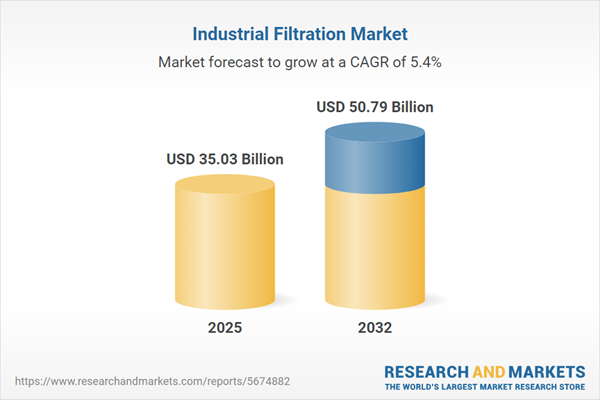Speak directly to the analyst to clarify any post sales queries you may have.
Industrial filtration forms the backbone of operational reliability and compliance within modern manufacturing. For senior decision-makers, effective filtration is not merely a support process but a strategic factor in maintaining quality, mitigating risk, and navigating evolving regulatory requirements.
Market Snapshot: Industrial Filtration Market
As of 2024, the global industrial filtration market stands at USD 33.25 billion. Escalating environmental regulations and amplified emphasis on risk management have accelerated adoption rates worldwide. The sector is projected to reach USD 35.03 billion by 2025, with continued growth anticipated through 2032, when it is expected to achieve USD 50.79 billion. Businesses are increasing investments in advanced filtration technologies to reinforce process dependability, excel in compliance, and strengthen their sustainability profiles. Filtration now represents a core element in shaping corporate strategy, enabling organizations to respond agilely to shifting standards and to solidify their market posture against the backdrop of regulatory transformation.
Scope & Segmentation of the Industrial Filtration Market
- Filter Types: Bag filters, cartridge filters, and HEPA filters guard air quality and enhance the consistency of sensitive processes. Gas filtration systems leverage adsorption and catalytic methods to uphold rigorous emission controls. Liquid filtration—spanning reverse osmosis, microfiltration, ultrafiltration, nanofiltration, membrane, and spin-on options—addresses the adaptability required in diverse industrial settings.
- Media Types: Ceramic and glass fiber media excel in harsh, high-temperature, or chemically aggressive environments. Stainless steel and nickel are favored for heavy-duty, continuous operations. Synthetic media, such as polyester and polypropylene, broaden industry applicability by balancing durability with cost efficiency.
- Operation Modes: Batch and continuous filtration modes support varying throughput demands and production line setups, offering resilience as manufacturing cycles or process recipes fluctuate.
- End-User Industries: Automotive, chemicals, petrochemicals, electronics, and power generation industries count on robust filtration to safeguard assets, improve finished product quality, and support uninterrupted operations under evolving standards.
- Regional Coverage: Asia-Pacific maintains leadership in adoption rates due to swift industrial growth and stringent regulations. Europe’s regulatory landscape fuels adaptive supply chain responses, while North America and other markets tailor investments to meet their local compliance and sustainability priorities.
- Key Players Reviewed: Leading manufacturers, including Donaldson, Parker-Hannifin, Eaton, MANN+HUMMEL, Pall Corporation, Camfil, 3M, Freudenberg, Cummins Filtration, and Ahlstrom-Munksjö, are driving advances in filter technologies that align with both client specifications and regulatory benchmarks.
Key Takeaways for Senior Decision-Makers
- Modern filtration strategies offer a robust route to ensuring regulatory compliance, minimizing operational risks, and supporting steady production even under variable external conditions.
- Embracing digital monitoring and control technologies empowers organizations to implement predictive maintenance, optimize asset lifespan, and prevent costly workflow interruptions.
- Ongoing improvements in membrane and filter media support more rigorous emission management and advance sustainability objectives in regulated industries.
- Comprehensive maintenance planning—including scheduled and predictive routines—extends equipment life and encourages continual alignment with changing regulations.
- Agile procurement, backed by supplier diversification and multi-source acquisition, enables rapid response to new market or compliance demands.
- Consistent collaboration with suppliers is crucial to sustaining reliable filtration system availability and addressing supply chain vulnerabilities that impact production continuity.
Tariff Impact on Supply Chain and Cost Structures
Recent U.S. tariff changes have increased cost and logistical complexity for filtration systems, particularly those dependent on metal-based parts. Organizations are mitigating these effects by expanding their supplier network geographically and introducing dual-sourcing arrangements. Investments in automation and service optimization further alleviate potential disruptions tied to trade policy shifts, supporting steady supply and cost control.
Methodology & Data Sources
This analysis draws from technical publications, in-depth regulatory studies, and exclusive industry data specific to the industrial filtration sector. Expert validation by market analysts and procurement professionals ensures the data aligns with current executive-level priorities and market trends.
Why This Report Matters
- Offers actionable guidance for strategic investment in advanced filtration, enriching risk management and compliance capabilities.
- Highlights how technology developments can reshape procurement and operational strategies, positioning organizations to meet dynamic market and regulatory expectations.
- Equips leaders to embed sustainability and best-practice compliance across enterprise-scale operations for sustained competitive advantage.
Conclusion
Industrial filtration is essential for stable, compliant, and resilient production environments. This report empowers executive decision-makers to advance procurement practices and reinforce the longevity of core manufacturing operations.
Additional Product Information:
- Purchase of this report includes 1 year online access with quarterly updates.
- This report can be updated on request. Please contact our Customer Experience team using the Ask a Question widget on our website.
Table of Contents
3. Executive Summary
4. Market Overview
7. Cumulative Impact of Artificial Intelligence 2025
Companies Mentioned
The companies profiled in this Industrial Filtration market report include:- Donaldson Company, Inc.
- Parker-Hannifin Corporation
- Eaton Corporation PLC
- MANN+HUMMEL GmbH
- Pall Corporation
- Camfil AB
- 3M Company
- Freudenberg SE
- Cummins Filtration LLC
- Ahlstrom-Munksjö Oyj
Table Information
| Report Attribute | Details |
|---|---|
| No. of Pages | 181 |
| Published | November 2025 |
| Forecast Period | 2025 - 2032 |
| Estimated Market Value ( USD | $ 35.03 Billion |
| Forecasted Market Value ( USD | $ 50.79 Billion |
| Compound Annual Growth Rate | 5.4% |
| Regions Covered | Global |
| No. of Companies Mentioned | 11 |









